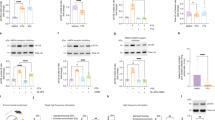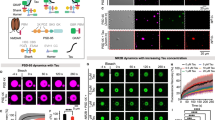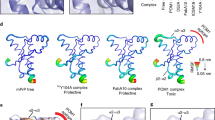Abstract
The neuronal isoform of cytoplasmic polyadenylation element–binding protein (CPEB) is a regulator of local protein synthesis at synapses and is critical in maintaining learning-related synaptic plasticity in Aplysia. Previous studies indicate that the function of Aplysia CPEB can be modulated by conversion to a stable prion-like state, thus contributing to the stabilization of long-term memory on a molecular level. Here, we used biophysical methods to demonstrate that Aplysia CPEB, like other prions, undergoes a conformational switch from soluble α-helix–rich oligomer to β-sheet–rich fiber in vitro. Solid-state NMR analyses of the fibers indicated a relatively rigid N-terminal prion domain. The fiber form of Aplysia CPEB showed enhanced binding to target mRNAs as compared to the soluble form. Consequently, we propose a model for the Aplysia CPEB fibers that may have relevance for functional prions in general.
Although significant knowledge of cellular and molecular mechanisms underlying the acquisition and early storage of implicit and explicit long-term memory has been gained, the mechanisms by which memories are maintained for long periods of time are still not fully understood1,2. Because proteins normally have relatively short half-lives, of hours or days, the question remains: How can the change in molecular composition of a synapse be maintained for long periods of time, as is required for long-term memory? We previously found one answer to this conundrum in a work describing a prion-like regulator of local protein synthesis at the synapse in the marine snail Aplysia californica: the cytoplasmic polyadenylation element–binding protein Aplysia CPEB3,4. This provided physiological evidence that the prion-like properties of Aplysia CPEB might explain the self-sustained, continuous molecular turnover at the synapse5.
This is a preview of subscription content, access via your institution
Access options
Subscribe to this journal
Receive 12 print issues and online access
$189.00 per year
only $15.75 per issue
Buy this article
- Purchase on Springer Link
- Instant access to full article PDF
Prices may be subject to local taxes which are calculated during checkout







Similar content being viewed by others
References
Bailey, C.H., Kandel, E.R. & Si, K. The persistence of long-term memory: a molecular approach to self-sustaining changes in learning-induced synaptic growth. Neuron Medline 44, 49–57 (2004).
Bailey, C.H. & Kandel, E.R. Synaptic remodeling, synaptic growth and the storage of long-term memory in Aplysia. Prog. Brain Res. 169, 179–198 (2008).
Si, K., Lindquist, S. & Kandel, E.R. A neuronal isoform of the Aplysia CPEB has prion-like properties. Cell 115, 879–891 (2003).
Si, K. et al. A neuronal isoform of CPEB regulates local protein synthesis and stabilizes synapse-specific long-term facilitation in Aplysia. Cell 115, 893–904 (2003).
Si, K., Choi, Y.B., White-Grindley, E., Majumdar, A. & Kandel, E.R. Aplysia CPEB can form prion-like multimers in sensory neurons that contribute to long-term facilitation. Cell Medline 140, 421–435 (2010).
McGrew, L.L., Dworkin-Rastl, E., Dworkin, M.B. & Richter, J.D. Poly(A) elongation during Xenopus oocyte maturation is required for translational recruitment and is mediated by a short sequence element. Genes Dev. 3, 803–815 (1989).
Gebauer, F. & Richter, J.D. Mouse cytoplasmic polyadenylylation element binding protein: an evolutionarily conserved protein that interacts with the cytoplasmic polyadenylylation elements of c-mos mRNA. Proc. Natl. Acad. Sci. USA 93, 14602–14607 (1996).
Liu, J. & Schwartz, J.H. The cytoplasmic polyadenylation element binding protein and polyadenylation of messenger RNA in Aplysia neurons. Brain Res. 959, 68–76 (2003).
DePace, A.H., Santoso, A., Hillner, P. & Weissman, J.S. A critical role for amino-terminal glutamine/asparagine repeats in the formation and propagation of a yeast prion. Cell 93, 1241–1252 (1998).
Glover, J.R. et al. Self-seeded fibers formed by Sup35, the protein determinant of [PSI+], a heritable prion-like factor of S. cerevisiae. Cell 89, 811–819 (1997).
Wickner, R.B. [URE3] as an altered URE2 protein: evidence for a prion analog in Saccharomyces cerevisiae. Science 264, 566–569 (1994).
Sondheimer, N. & Lindquist, S. Rnq1: an epigenetic modifier of protein function in yeast. Mol. Cell 5, 163–172 (2000).
Prusiner, S.B. Prions. Proc. Natl. Acad. Sci. USA 95, 13363–13383 (1998).
Harrison, P.M., Bamborough, P., Daggett, V., Prusiner, S.B. & Cohen, F.E. The prion folding problem. Curr. Opin. Struct. Biol. 7, 53–59 (1997).
Heinrich, S.U. & Lindquist, S. Protein-only mechanism induces self-perpetuating changes in the activity of neuronal Aplysia cytoplasmic polyadenylation element binding protein (CPEB). Proc. Natl. Acad. Sci. USA 108, 2999–3004 (2011).
Majumdar, A. et al. Critical role of amyloid-like oligomers of Drosophila Orb2 in the persistence of memory. Cell 148, 515–529 (2012).
Pavlopoulos, E. et al. Neuralized1 activates CPEB3: a function for nonproteolytic ubiquitin in synaptic plasticity and memory storage. Cell 147, 1369–1383 (2011).
Nagase, T. et al. Prediction of the coding sequences of unidentified human genes. XV. The complete sequences of 100 new cDNA clones from brain which code for large proteins in vitro. DNA Res. 6, 337–345 (1999).
Wacker, J.L., Zareie, M.H., Fong, H., Sarikaya, M. & Muchowski, P.J. Hsp70 and Hsp40 attenuate formation of spherical and annular polyglutamine oligomers by partitioning monomer. Nat. Struct. Mol. Biol. 11, 1215–1222 (2004).
Lobley, A., Whitmore, L. & Wallace, B.A. DICHROWEB: an interactive website for the analysis of protein secondary structure from circular dichroism spectra. Bioinformatics 18, 211–212 (2002).
Whitmore, L. & Wallace, B.A. DICHROWEB, an online server for protein secondary structure analyses from circular dichroism spectroscopic data. Nucleic Acids Res. 32, W668–W673 (2004).
Zandomeneghi, G., Krebs, M.R., McCammon, M.G. & Fandrich, M. FTIR reveals structural differences between native β-sheet proteins and amyloid fibrils. Protein Sci. 13, 3314–3321 (2004).
LeVine, H. III. Thioflavine T interaction with synthetic Alzheimer′s disease β-amyloid peptides: detection of amyloid aggregation in solution. Protein Sci. 2, 404–410 (1993).
Wickner, R.B., Dyda, F. & Tycko, R. Amyloid of Rnq1p, the basis of the [PIN+] prion, has a parallel in-register β-sheet structure. Proc. Natl. Acad. Sci. USA 105, 2403–2408 (2008).
Shewmaker, F. et al. The functional curli amyloid is not based on in-register parallel β-sheet structure. J. Biol. Chem. 284, 25065–25076 (2009).
Jabet, C., Sprague, E.R., VanDemark, A.P. & Wolberger, C. Characterization of the N-terminal domain of the yeast transcriptional repressor Tup1. Proposal for an association model of the repressor complex Tup1 x Ssn6. J. Biol. Chem. 275, 9011–9018 (2000).
Dueholm, M.S. et al. Functional amyloid in Pseudomonas. Mol. Microbiol. Medline 77, 1009–1020 (2010).
Fowler, D.M. et al. Functional amyloid formation within mammalian tissue. PLoS Biol. 4, e6 (2006).
Maji, S.K. et al. Functional amyloids as natural storage of peptide hormones in pituitary secretory granules. Science 325, 328–332 (2009).
Barnhart, M.M. & Chapman, M.R. Curli biogenesis and function. Annu. Rev. Microbiol. 60, 131–147 (2006).
Pines, A., Gibby, M.G. & Waugh, J.S. Proton-enhanced NMR of dilute spins in solids. J. Chem. Phys. 59, 569–590 (1973).
Burum, D.P. & Ernst, R.R. Net polarization transfer via a J-ordered state for signal enhancement of low-sensitivity nuclei. J. Magn. Reson. 39, 163–168 (1980).
Levitt, M.H. Spin Dynamics: Basics of Nuclear Magnetic Resonance (Wiley, 2001).
Siemer, A.B. et al. Observation of highly flexible residues in amyloid fibrils of the HET-s prion. J. Am. Chem. Soc. 128, 13224–13228 (2006).
Helmus, J.J., Surewicz, K., Nadaud, P.S., Surewicz, W.K. & Jaroniec, C.P. Molecular conformation and dynamics of the Y145Stop variant of human prion protein in amyloid fibrils. Proc. Natl. Acad. Sci. USA 105, 6284–6289 (2008).
Loquet, A. et al. Prion fibrils of Ure2p assembled under physiological conditions contain highly ordered, natively folded modules. J. Mol. Biol. 394, 108–118 (2009).
Hu, K.N., McGlinchey, R.P., Wickner, R.B. & Tycko, R. Segmental polymorphism in a functional amyloid. Biophys. J. 101, 2242–2250 (2011).
Spera, S., Ikura, M. & Bax, A. Measurement of the exchange rates of rapidly exchanging amide protons: application to the study of calmodulin and its complex with a myosin light chain kinase fragment. J. Biomol. NMR 1, 155–165 (1991).
Bax, A. & Freeman, R. Investigation of complex networks of spin-spin coupling by two-dimensional NMR. J. Magn. Reson. 44, 542–561 (1981).
Helmus, J.J., Surewicz, K., Surewicz, W.K. & Jaroniec, C.P. Conformational flexibility of Y145Stop human prion protein amyloid fibrils probed by solid-state nuclear magnetic resonance spectroscopy. J. Am. Chem. Soc. 132, 2393–2403 (2010).
Ritter, C. et al. Correlation of structural elements and infectivity of the HET-s prion. Nature 435, 844–848 (2005).
Fiumara, F., Fioriti, L., Kandel, E.R. & Hendrickson, W.A. Essential role of coiled coils for aggregation and activity of Q/N-rich prions and polyQ proteins. Cell Medline 143, 1121–1135 (2010).
Sambashivan, S., Liu, Y., Sawaya, M.R., Gingery, M. & Eisenberg, D. Amyloid-like fibrils of ribonuclease A with three-dimensional domain-swapped and native-like structure. Nature 437, 266–269 (2005).
Schneider, C.A., Rasband, W.S. & Eliceiri, K.W. NIH Image to ImageJ: 25 years of image analysis. Nat. Methods 9, 671–675 (2012).
Puthanveettil, S.V. et al. A new component in synaptic plasticity: upregulation of kinesin in the neurons of the gill-withdrawal reflex. Cell 135, 960–973 (2008).
Marley, J., Lu, M. & Bracken, C. A method for efficient isotopic labeling of recombinant proteins. J. Biomol. NMR 20, 71–75 (2001).
Siemer, A.B. & McDermott, A.E. Solid-state NMR on a type III antifreeze protein in the presence of ice. J. Am. Chem. Soc. 130, 17394–17399 (2008).
Acknowledgements
We are extremely grateful to K. Si (Stowers Institute for Medical Research, Kansas City, Missouri, USA) for providing the plasmids used in this study and to S. Jokusch (Columbia University) for helping us with FTIR spectra and real-time fluorescence measurement. We would like to acknowledge and thank J. Lidestri, (Columbia University) and H. Park (Scripps Research Institute) for assisting with X-ray diffraction analyses of the fibers. We are grateful to K. Nakanishi and N. Berova (Columbia University) for their guidance in CD analysis and to M.A. Gawinowicz (Columbia University) for MS analysis of the protein fragments. This work was supported by the Howard Hughes Medical Institute, US National Institutes of Health (grant MH075026; E.R.K.) and US National Science Foundation (grant MCB0316248; A.E.M.).
Author information
Authors and Affiliations
Contributions
B.L.R., S.V.P. and A.B.S. designed the project after discussing with E.R.K., A.E.M. and W.A.H. All the experiments were done by B.L.R. except NMR and RNA-binding experiments. NMR experiments were done by A.B.S. and RNA-binding experiments by S.V.P. B.L.R., A.B.S., E.R.K. and A.E.M. wrote the paper.
Corresponding authors
Ethics declarations
Competing interests
The authors declare no competing financial interests.
Supplementary information
Supplementary Text and Figures
Supplementary Figures 1–5 and Supplementary Table 1 (PDF 1935 kb)
Rights and permissions
About this article
Cite this article
Raveendra, B., Siemer, A., Puthanveettil, S. et al. Characterization of prion-like conformational changes of the neuronal isoform of Aplysia CPEB. Nat Struct Mol Biol 20, 495–501 (2013). https://doi.org/10.1038/nsmb.2503
Received:
Accepted:
Published:
Issue Date:
DOI: https://doi.org/10.1038/nsmb.2503
This article is cited by
-
Divergent CPEB prion-like domains reveal different assembly mechanisms for a generic amyloid-like fold
BMC Biology (2021)
-
ApCPEB4, a non-prion domain containing homolog of ApCPEB, is involved in the initiation of long-term facilitation
Molecular Brain (2016)
-
Identification and Structural Characterization of the N-terminal Amyloid Core of Orb2 isoform A
Scientific Reports (2016)
-
Dynamic domains of amyloid fibrils can be site-specifically assigned with proton detected 3D NMR spectroscopy
Journal of Biomolecular NMR (2016)
-
ALS—dying forward, backward or outward?
Nature Reviews Neurology (2014)



